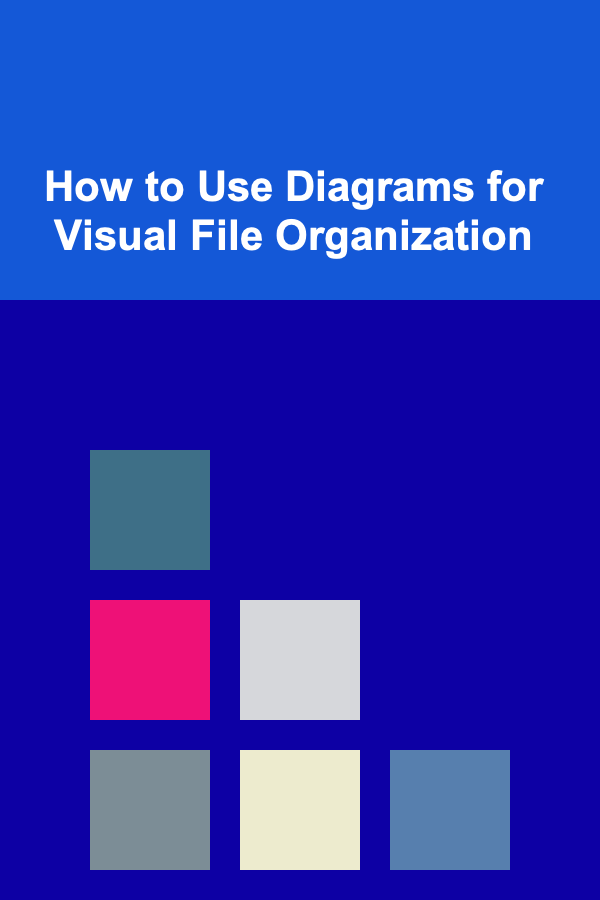
How to Use Diagrams for Visual File Organization
ebook include PDF & Audio bundle (Micro Guide)
$12.99$9.99
Limited Time Offer! Order within the next:

In an age where information overload is common, effective file organization is crucial for both personal and professional success. A well-structured file system not only enhances productivity but also reduces stress associated with locating important documents. One innovative method for file organization is the use of diagrams. This article will delve into various types of diagrams, their applications, and the best practices for utilizing them in visual file organization.
Introduction to Visual File Organization
The digital era has transformed how we store and manage information. With countless files and documents created daily, having a visual organization system becomes indispensable. Traditional filing methods often lead to confusion and clutter, making it challenging to retrieve necessary documents efficiently.
Visual organization leverages diagrams to create a clear representation of your files and folders. By mapping out your file structure visually, you can enhance your ability to navigate complex systems quickly and intuitively. This method not only simplifies the retrieval process but also allows for a more holistic understanding of your data.
Understanding Diagrams
Diagrams are graphical representations of information that help convey complex ideas clearly and concisely. They serve as visual aids that can simplify relationships, processes, and hierarchies within a file organization system.
Types of Diagrams
There are several types of diagrams that can be employed in visual file organization. Each serves a different purpose and can be used in various contexts:
- Mind Maps: Ideal for brainstorming and organizing ideas hierarchically.
- Flowcharts: Useful for depicting processes and workflows.
- Tree Diagrams: Great for showing hierarchical relationships and branching structures.
- Concept Maps: Effective for illustrating relationships between concepts.
- Venn Diagrams: Useful for comparing and contrasting different sets of information.
Benefits of Using Diagrams
Utilizing diagrams for file organization offers several advantages:
- Enhanced Clarity: Diagrams provide a visual representation that makes complex information easier to understand.
- Improved Memory Retention: Visual aids can enhance recall and retention of information.
- Better Navigation: A well-structured diagram allows for intuitive navigation through files and folders.
- Time Efficiency: Quickly locating files reduces the time spent searching for documents.
- Encourages Creativity: Visual thinking can stimulate creative problem-solving and innovation.
Implementing Diagrams for File Organization
To effectively implement diagrams in your file organization strategy, it's essential to understand how each type of diagram can be utilized. Below, we explore various diagram types and their specific applications.
Mind Maps
Mind maps are excellent tools for brainstorming and organizing thoughts in a non-linear fashion. They allow individuals to visually represent ideas and their relationships.
How to Create a Mind Map for File Organization
- Central Idea: Start by writing down the main theme or purpose of your file organization (e.g., "Project X").
- Branching Ideas: Create branches for major categories related to the central idea (e.g., "Reports," "Research," "Presentations").
- Subcategories: Add sub-branches for more specific topics under each category.
- Color Coding: Use different colors for categories to enhance visual appeal and clarity.
Example
Imagine organizing files for a marketing project. Your mind map might look like this:
- Project X
- Research
- Market Analysis
- Competitor Overview
- Reports
- Monthly Updates
- Yearly Summary
- Presentations
- Stakeholder Meeting
- Team Briefing
- Research
Flowcharts
Flowcharts are ideal for illustrating processes and decision-making paths. They can help you visualize the steps involved in file management and organization.
How to Create a Flowchart for File Organization
- Define the Process: Identify the process you want to document (e.g., file naming conventions).
- Start and End Points: Mark the starting point and endpoint of the process.
- Identify Steps: List all the steps involved, using shapes to represent each step (ovals for start/end, rectangles for processes, diamonds for decisions).
- Connect the Dots: Use arrows to show the flow of the process.
Example
A flowchart for naming files might look like this:
↘
→ {Is it a Presentation?} → [Use Presentation Naming Convention]
↗
[End]
Tree Diagrams
Tree diagrams are useful for showing hierarchical relationships, making them great for organizing files based on categories and subcategories.
How to Create a Tree Diagram for File Organization
- Root Node: Begin with a root node representing the main category (e.g., "Documents").
- Branches: Create branches for major categories (e.g., "Personal," "Work").
- Sub-Branches: Continue adding sub-branches as needed for further categorization.
Example
A tree diagram for a personal document organization system might look like this:
├── Personal
│ ├── Finances
│ ├── Health Records
│ └── Travel
└── Work
├── Projects
│ ├── Project A
│ └── Project B
└── Reports
Concept Maps
Concept maps are versatile tools that help illustrate the relationships between different concepts. They can be particularly useful for connecting various files and categories.
How to Create a Concept Map for File Organization
- Identify Concepts: List the key concepts or categories related to your files.
- Draw Connections: Use lines to connect related concepts, labeling the connections if necessary.
- Hierarchical Structure: Arrange the concepts in a way that reflects their relationships.
Example
A concept map for an academic project might include:
↑ ↑
Previous Studies ---→ Current Study
↓ ↓
Future Work ---→ Recommendations
Venn Diagrams
Venn diagrams are effective for comparing and contrasting different sets of information. They can help highlight similarities and differences between files or categories.
How to Create a Venn Diagram for File Organization
- Identify Sets: Determine the sets you want to compare (e.g., "Research Articles" vs. "Case Studies").
- Draw Circles: Create overlapping circles for each set.
- Label the Circles: Clearly label each circle and fill in the overlapping area with shared characteristics or themes.
Example
A Venn diagram comparing "Research Articles" and "Case Studies" might look like this:
/ \
/ \
[Similarities] [Unique Characteristics]
\ /
\ /
[Case Studies]
Tools for Creating Diagrams
Numerous tools are available to help you create effective diagrams for file organization. Here are some popular options:
- MindMeister: An online mind mapping tool that allows for collaborative brainstorming.
- Lucidchart: A versatile diagramming application suitable for flowcharts, tree diagrams, and more.
- Coggle: A simple tool for creating mind maps collaboratively.
- XMind: A powerful mind mapping software with various templates and styles.
- Google Drawings: A free tool within Google Drive that allows for creating basic diagrams and flowcharts.
Best Practices for Visual File Organization
To maximize the effectiveness of your visual file organization system, consider these best practices:
- Keep it Simple: Avoid overly complex diagrams. Aim for clarity and simplicity.
- Use Consistent Symbols: Adopt standard symbols for different diagram types to promote understanding.
- Regular Updates: Periodically review and update your diagrams to reflect changes in your file organization.
- Label Clearly: Ensure that all elements of your diagrams are clearly labeled for easy understanding.
- Backup Your Diagrams: Keep digital copies of your diagrams to prevent loss and facilitate sharing.
Case Studies: Success Stories
Case Study 1: A Marketing Agency
A small marketing agency struggled with document management due to the volume of projects and client files. They implemented a combination of mind maps and flowcharts to organize their files.
- Mind Maps were used to brainstorm project ideas and categorize client files.
- Flowcharts illustrated the workflow for each project, making it easy for team members to understand their roles and responsibilities.
As a result, the agency reported a significant reduction in time spent searching for files and improved collaboration among team members.
Case Study 2: A University Student
A university student faced challenges in managing research materials for her thesis. She adopted a tree diagram to organize her sources and notes.
- The root node represented her thesis topic, with branches for different themes and sub-branches for individual articles and notes.
- This visual representation allowed her to quickly locate relevant materials and see connections between different concepts.
The student successfully completed her thesis ahead of schedule, crediting her organized approach as a key factor in her efficiency.
Conclusion
Using diagrams for visual file organization offers a powerful method for enhancing clarity, improving navigation, and streamlining document management. By implementing mind maps, flowcharts, tree diagrams, concept maps, and Venn diagrams, individuals and organizations can optimize their file systems effectively.
As demonstrated through case studies, the thoughtful integration of visual aids can lead to significant improvements in productivity and efficiency. By embracing these techniques and tools, anyone can create a well-organized and intuitive file management system that facilitates quick access to essential documents and enhances overall workflow.
Reading More From Our Other Websites
- [Home Family Activity 101] How to Plan a Family Ice Cream Sundae Bar Night
- [Scrapbooking Tip 101] Seasonal Spark: Curating Themed Scrapbooking Paper Collections for Year-Round Projects
- [Home Lighting 101] How to Light a Basement to Combat the Dungeon Effect
- [Home Cleaning 101] How to Tackle Outdoor Cleaning Tips: Preparing Your Deck and Patio for Summer Fun
- [Home Cleaning 101] How to Streamline Your Move-in Cleaning Checklist for a Spotless Start
- [Digital Decluttering Tip 101] From Chaos to Order: Organizing Cloud Storage and Backups for Maximum Efficiency
- [Organization Tip 101] How to Maintain Records of Past Tenant History
- [Home Soundproofing 101] How to Use Rugs and Carpets for Natural Soundproofing
- [Simple Life Tip 101] How to Use Minimalist Principles to Streamline Your Social Media Usage
- [Reading Habit Tip 101] Best Methods for Maintaining a Reading Habit While Traveling Internationally

How to Automate Your Savings for Long-Term Wealth
Read More
How to Create a Functional Kitchen Layout for Efficiency
Read More
How to Turn Deep Learning into a Profitable Side Business
Read More
How to Use Smart Locks to Enhance Your Home Security
Read More
How to Use ChatGPT for Property Description Writing
Read More
10 Tips for Mastering Beatmatching by Ear
Read MoreOther Products

How to Automate Your Savings for Long-Term Wealth
Read More
How to Create a Functional Kitchen Layout for Efficiency
Read More
How to Turn Deep Learning into a Profitable Side Business
Read More
How to Use Smart Locks to Enhance Your Home Security
Read More
How to Use ChatGPT for Property Description Writing
Read More